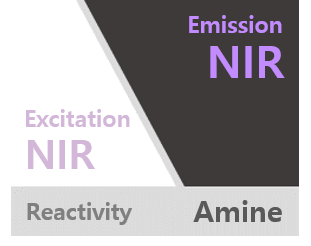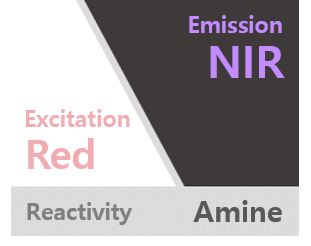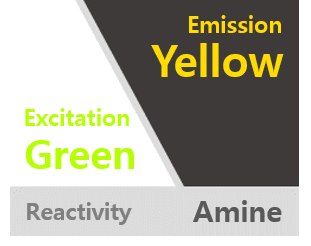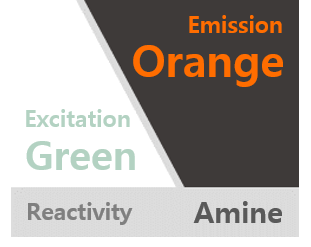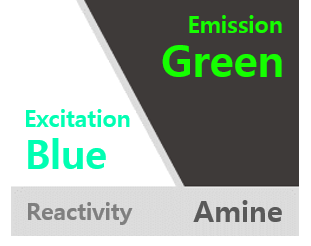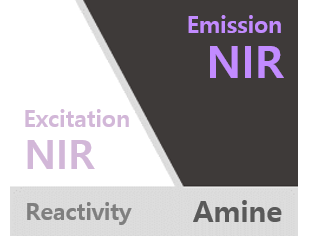
 >
Products
>
>
>
>
Products
>
>
>
- Flamma® Fluors NHS ester
- Flamma® Fluors Sulfo-NHS ester
- Flamma® Fluors Vinylsulfone
- Flamma® Fluors Isothiocyanate
- Flamma® Fluors Maleimide
- Flamma® Fluors Hydrazide
- Flamma® Fluors Dichlorotriazine
- Flamma® Fluors Carboxylic acid
- Flamma® Fluors Amine
- Flamma® Fluors Thiol
- Flamma® Fluors Alkyne
- Flamma® Fluors PEG4-Alkyne
- Flamma® Fluors ADIBO
- Flamma® Fluors Azide
Flamma® 675 NHS ester
| PACKING UNIT | price |
Lead time |
|---|---|---|
| 1 mg | $121.00 | |
| 5 mg | $347.00 | |
| 25 mg | $735.00 |
Description
Flamma® Fluors 675 NHS ester is a reactive form of near infrared (NIR) fluorescent dye induced from benzindocyanine structure and used to generate a stable fluorescence signal in bioimaging. The maxima of Ex/Em values are at 675/691 nm, similar to that of Alexa 680, Cy5.5, IRDye 680LT and Dylight 680. Flamma 675 might be excited using the 633 nm laser line and the emission occurs at biological tissue permeable NIR region. Flamma 675 dye can be conjugated to low-abundance biomolecules in fixed cells with great sensitivity, and NIR emission allows in vitro imaging in biological studies. NHS esters readily react with amine-modified oligonucleotides or amino groups of proteins, i.e. the ε-amino groups of lysine or the amine terminus of nucleotides to form a chemically stable amide bond between dye and the biomolecule. We offer Flamma Fluors 675 dye for labeling of antibodies, peptides, proteins, ligands, and amplification substrates optimized for in vitro imaging.
Citation & Reference
1. Park J-H, Prediction of the minimum amount of anti-adhesive agent required for entire intra-abdominal cavity using fluorescent dye. Korean Journal of Clinical Oncology. 2024 Jun 30;20(1):18–26.
2. Vadevoo SM, IL4 receptor targeting enables NAB-paclitaxel to enhance reprogramming of M2-type macrophages into M1-like phenotype via Ros-HMGB1-TLR4 axis and inhibition of tumor growth and metastasis. Theranostics. 2024;14(6):2605-21.
3. Kim Y-M, Effect of tryptophan position and lysine/arginine substitution in antimicrobial peptides on antifungal action. Biochemical and Biophysical Research Communications. 2024 Apr;704:149700.
4. Le NT, Viscosity regulation of chemically simple condensates. Biomacromolecules. 2024 Aug 21;25(9):5959–67.
5. Park S-C, Antifungal action of Arabidopsis thaliana TCP21 via induction of oxidative stress and apoptosis. Antioxidants. 2023 Sept 15;12(9):1767.
6. Kim J, Micro-syringe chip-guided intratumoral administration of lipid nanoparticles for targeted anticancer therapy. Biomaterials Research. 2023 Feb 9;27(1).
7. Kang N-W, Hydroxyapatite-binding albumin nanoclusters for enhancing bone tumor chemotherapy. Journal of Controlled Release. 2022 Feb;342:111–21.
8. Hlaing SP, Hyaluronic acid-conjugated plga nanoparticles alleviate ulcerative colitis via CD44-mediated dual targeting to inflamed colitis tissue and macrophages. Pharmaceutics. 2022 Oct 5;14(10):2118.
9. Kim H, Harnessing the natural healing power of colostrum: Bovine milk‐derived extracellular vesicles from colostrum facilitating the transition from inflammation to tissue regeneration for accelerating cutaneous wound healing. Advanced Healthcare Materials. 2021 Dec 16;11(6).
10. Han SJ, Electric fields regulate cellular elasticity through intracellular Ca2+ concentrations. Journal of Cellular Physiology. 2021 May 16;236(11):7450–63. doi:10.1002/jcp.30417
11. Bae SM, PSP1, a phosphatidylserine-recognizing peptide, is useful for visualizing radiation-induced apoptosis in colorectal cancer in vitro and in vivo. Translational Oncology. 2018 Aug;11(4):1044–52.
12. Yhee, Ji Young. Cancer-targeted MDR-1 siRNA delivery using self-cross-linked glycol chitosan nanoparticles to overcome drug resistance. Journal of Controlled Release 198 (2015): 1-9.
13. Oh, Keun Sang. Accurate sequential detection of primary tumor and metastatic lymphatics using a temperature-induced phase transition nanoparticulate system. International journal of nanomedicine 9 (2014): 2955.
14. Yoon, Hong Yeol. Glycol chitosan nanoparticles as specialized cancer therapeutic vehicles: Sequential delivery of doxorubicin and Bcl-2 siRNA. Scientific reports 4 (2014).
15. Hollis, Christin P. In vivo investigation of hybrid paclitaxel nanocrystals with dual fluorescent probes for cancer theranostics. Pharmaceutical research 31.6 (2014): 1450-1459.
16. Yhee, Ji Young. Tumor-targeting transferrin nanoparticles for systemic polymerized siRNA delivery in tumor-bearing mice. Bioconjugate chemistry 24.11 (2013): 1850-1860.
17. Yoon, Hong Yeol. Bioreducible hyaluronic acid conjugates as siRNA carrier for tumor targeting. Journal of Controlled Release 172.3 (2013): 653-661.
18. Park, Jin Woo. Wide-Ranged Fluorescent Molecular Weight Size Markers for Electrophoresis. Bulletin of the Korean Chemical Society 34.1 (2013): 29-30.
19. Koo, Heebeom. The movement of self-assembled amphiphilic polymeric nanoparticles in the vitreous and retina after intravitreal injection. Biomaterials 33.12 (2012): 3485-3493.
20. Zhu, Lei. Real-time monitoring of caspase cascade activation in living cells. Journal of controlled release 163.1 (2012): 55-62.
21. Huang, Xinglu. Multiplex Imaging of an Intracellular Proteolytic Cascade by using a Broad?Spectrum Nanoquencher. Angewandte Chemie International Edition 51.7 (2012): 1625-1630.
22. Ryu, Ju Hee. Early diagnosis of arthritis in mice with collagen?induced arthritis, using a fluorogenic matrix metalloproteinase 3–specific polymeric probe. Arthritis & Rheumatism 63.12 (2011): 3824-3832.
23. Ibrahim, Basma M. A strategy to deliver genes to cystic fibrosis lungs: a battle with environment. Journal of controlled release 155.2 (2011): 289-295.
24. Xu, Peisheng. Zwitterionic chitosan derivatives for pH-sensitive stealth coating. Biomacromolecules 11.9 (2010): 2352-2358.
OPTION
Total

 log
log My
My Contact
Contact
